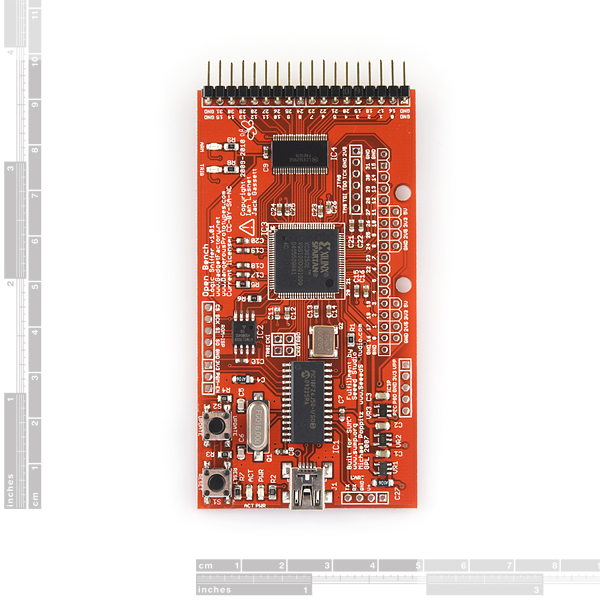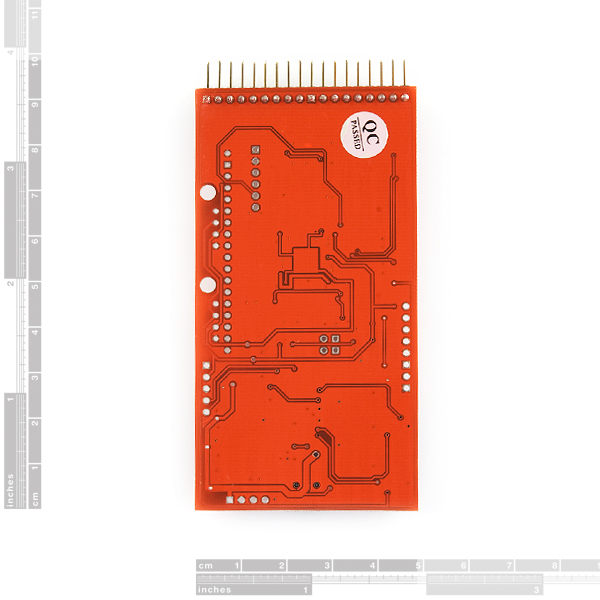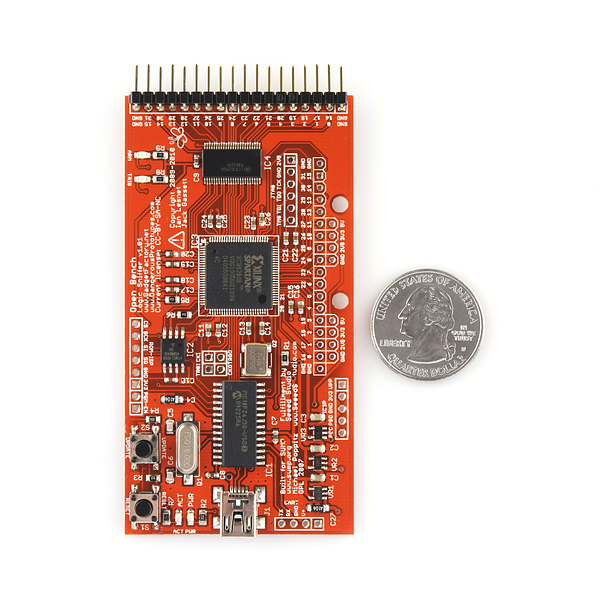Open Logic Sniffer
The Open Workbench Logic Sniffer is an open source logic analyzer with a USB interface. The hardware is designed for the SUMP open source logic analyzer client and toolchain.
- Capture 50MHz+ waveforms on 32 channels
- 200Msps captures up to 100MHz waveforms on 16 channels
- 100Msps captures up to 50MHz waveforms on 32 channels
- 16 buffered channels, 5 volt tolerant
- M74LCX16245DTR2G transceiver tolerates voltages from -0.5V to +7V.
- 216K Block RAM supports following memory configurations*
- 8 channels with 24K sample depth
- 16 channels with 12K sample depth
- 32 channels with 6K sample depth
- External clock and trigger input
- Allows interfacing with external test equipment and daisy chaining OLS's for additional channels.
- Internal clock and trigger output
- 16bit wing expansion header
- USB interface, USB powered
- USB upgradable everything
- Designed for the SUMP logic analyzer client
- Open source
Open Logic Sniffer Product Help and Resources
Core Skill: Soldering
This skill defines how difficult the soldering is on a particular product. It might be a couple simple solder joints, or require special reflow tools.
Skill Level: Noob - Some basic soldering is required, but it is limited to a just a few pins, basic through-hole soldering, and couple (if any) polarized components. A basic soldering iron is all you should need.
See all skill levels
Core Skill: Programming
If a board needs code or communicates somehow, you're going to need to know how to program or interface with it. The programming skill is all about communication and code.
Skill Level: Competent - The toolchain for programming is a bit more complex and will examples may not be explicitly provided for you. You will be required to have a fundamental knowledge of programming and be required to provide your own code. You may need to modify existing libraries or code to work with your specific hardware. Sensor and hardware interfaces will be SPI or I2C.
See all skill levels
Core Skill: Electrical Prototyping
If it requires power, you need to know how much, what all the pins do, and how to hook it up. You may need to reference datasheets, schematics, and know the ins and outs of electronics.
Skill Level: Experienced - You will need to consult a datasheet for calculations to determine a components output format, linearity, and do a little math to get what you need. You will be using a datasheet or schematic beyond basic pinouts.
See all skill levels
Comments
Looking for answers to technical questions?
We welcome your comments and suggestions below. However, if you are looking for solutions to technical questions please see our Technical Assistance page.
Customer Reviews
No reviews yet.





Sorry to be a whiner but there's not much incentive to buy this here if I can buy it elsewhere for $20 - $30 less.
So, what is the answer to the price increase question?
Is it just an error or something?
which are you smoking?
wow great product!
now we need a great ponoko case for it ;)
anyone?
Member167022:
OMG WHY HAS THE PRICE INCREASED BY $20?
[SPARKFUN staff pls reply ASAP, thanks]
(Below is a pic/screenshot of google-cache to illustrate what i mean)
http://img810.imageshack.us/img810/7559/sparkfun.jpg
Hi,
When will this product be available again on sparkfun ?
It was a cheap logic analizer that I would want to buy
but.. surprise.. nobody sells this item right now..
Do not buy! This product hasn't been supported for years and Win8.1 drivers do not exist.. I do not understand why sparkfun is still selling this out of date board..
$70 down the drain..
Sorry to hear you were so dissatisfied with this. This isn't a product that we make in-house and is a slow seller, which is why it fell through the cracks on updates and such. I'll make sure this gets addressed. Thank you for the feedback!
Initially I had problems with getting the drivers to work with windows 8 as they need signing. I posted the procedure to manually sign the drivers here. Once the drivers are signed it works great!
To save someone the headache I just went through, here are the problems I experienced, and their solutions. At a high level, my problem was related to having OLD FPGA and PIC firmware on the board. After taking one sample, I had to press RESET on the OLS board to obtain a new sample, otherwise the data would be logic low/zeros (no data). DO NOT assume that since your board was made in 2013 (mine was) that it has the latest FW revs loaded!
I had originally started out by downloading the "Alternative OLS Client" (http://ols.lxtreme.nl/). However, I realized I needed the PIC drivers so that the OLS was detected/configured properly in WINXP. To obtain the correct drivers, download the "original" OLS client v3.08 (http://logicsniffer.gadgetfactory.net/index.php?n=LogicSniffer.Download). Within that distro you should find the "Drivers" directory - run the batch file to install the Microchip drivers. After I had installed the drivers, I started the Alternative OLS Client (Note - I did not use the 3.08 sniffer client - it was only used to obtain the Microchip drivers). This is where I discovered the issue where I could only obtain sample data AFTER pressing the RESET button on the OLS hardware. A search led me to this VERY HELPFUL thread (http://dangerousprototypes.com/forum/viewtopic.php?t=5411&p=51881). I had experienced the exact same behavior, and followed the thread author's advice. Ultimately I ended up using the v3 Demon Verilog FPGA firmware, and the v3.0 Microchip PIC firmware. To load BOTH the PIC firmware and FPGA firmware, I used the "Logic Sniffer Image Loader" referenced in the thread above (http://www.mygizmos.org/ols/olswinloader.html). He is also the designer of the v3 Demon core for the FPGA (http://www.mygizmos.org/ols/fpga.html). Much thanks to him! Note that the v3.0 PIC firmware will be found in the v3.08 Logic Sniffer client folders (OLS-Upgrader --> PIC_firmware). As an aside, I only used the v3.08 OLS Client for the PIC drivers and PIC firmware binaries. v3.08 works but the "alternative" client has many more features and is maintained (current as of Aug 2013).
You will be using the .hex files for the PIC upgrade, and the .bit for the FPGA. Use the default settings for the upgrade tool. After upgrading my firmware I was able to use the 0.9.7 Alternative OLS client and obtain captures without resetting the board! Wooot! I could also read the device's metadata (no data returned w/ old FW). I will add it might be worth browsing this page for "extras" regarding the OLS (http://www.mygizmos.org/ols/index.html#CASE).
Hopefully this will help someone out!
Am I right if I guess that this will not be fast enough to analyze a floppy disk drive? I want to interface with an old 5.25" drive I have in my Kaypro II.
Well, I guess I am more afraid that it wont hold enough in its buffer...
I am really put off with how this produce is presented. I guess I should have looked harder at the bloody USB connector. I've got the damned thing in my hand now and I have never, ever seen that kind of USB connection before in my life. It would have been nice if Sparkfun had either put a cable in with the board or at least specified which kind of bloody connector they'd used on the board. :-(
It looks a lot like USB mini-B. I have about 10 cables in my house right now.
This looks great. I read through a bunch of the documentation that is available for this, but I'm wondering:
1. What is the risk of this software becoming unsupported? Sounds like only one guy knows the SUMP code.
2. Can you do complex triggering like triggering on a specific byte or similar?
Can anyone help me out with how to install the USB Drivers for this thing for Windows 7?
OK, they sold out quickly. They were 'in-stock' when I checked.
GadgetFactory is doing there own 'run' and have a few 'in-stock' at this moment!
http://www.gadgetfactory.net/index.php?main_page=product_info&cPath=10&products_id=30
Any chance these will be in before Christmas?
Stock Date Please?
It is available at<br />
<br />
http://www.seeedstudio.com/depot/preorder-open-workbench-logic-sniffer-p-612.html?cPath=75<br />
<br />
This is where I got mine (prior to SF making it available to us on this site).<br />
<br />
Yes, it will take a week or two for it to arrive.
Sorry, no ETA at this time.
Before using, please update firmware to 0.6 and fpga rom to 2.12. Before doing this it was pretty useless (for me at least)
Any chance of getting a low cost breakout board for the MC74LCX16245?
Anyone have this working reliably on OS X?
I have. The original sump client is written in Java, so it is crossplatform. You do however need the RXTX library. You can find more info here: http://dangerousprototypes.com/forum/index.php?board=23.0
As for myself, I prefer the so called Alternative Client. It has the RXTX library imbedded, and is under active development. I has some more features than the original SUMP client too. You can find it here: http://github.com/jawi/ols or the direct download to the latest version: http://www.lxtreme.nl/ols/ols-0.8.3.tar.gz
This looks cool. I have an S3BOARD which I bought primarily to run the SUMP logic analyzer. The advantage of the S3BOARD is that it has a 1MB SRAM which means it can store 32 channels with 256k sample depth. The disadvantage is that it lacks input protection, only has RS232 serial, and costs over twice as much as this guy. (though I notice the PICFPGA communication on the OLS is currently limited to the same 115200baud as the S3BOARD is)
I haven't looked at the dangerousprototypes board in detail, but it might also be useful as a FPGA starter board--use the 16 protected pins as inputs, and design a level-shifting output daughercard for the remaining 16 pins (It looks like the I/O voltage is 3.3v in their design, but verify this before damaging a board). You can develop for the Spartan-3E chip using the no-cost version of Xilinx ISE, which runs on Linux and Windows.
Actually the SUMP core has been modified, it communicates over SPI with the PIC now. USB communication with the pc is now over 1 MegaBaud.
Daughterboards are currently in development.
Thanks for the correction; I was jumping to conclusions based on something from the sniffer's wiki and don't doubt that I got it wrong.